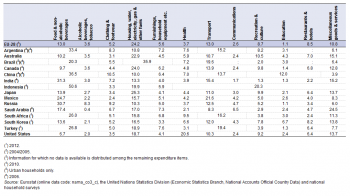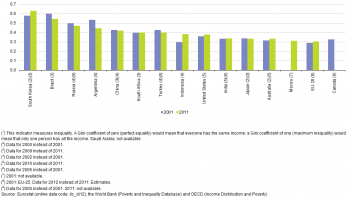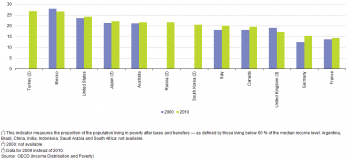Archive:The EU in the world - living conditions
- Data from February 2014. Most recent data: Further Eurostat information, Main tables and Database. Planned article update: May 2015.
This article is part of a set of statistical articles based on Eurostat’s publication The EU in the world 2014.
The article focuses on living conditions and social protection in the European Union (EU) and in the 15 non-EU countries from the Group of Twenty (G20). It covers indicators related to income, expenditure, poverty and social protection and gives an insight into society in the EU in comparison with the major economies in the rest of the world, such as its counterparts in the so-called Triad — Japan and the United States — and the BRICS composed of Brazil, Russia, India, China and South Africa.

(% of total) - Source: Eurostat (ilc_lvph03), the United Nations Department of Economic and Social Affairs (Demographic statistics) and national surveys

(% of total household consumption expenditure) - Source: Eurostat (nama_co3_c), the United Nations Statistics Division (Economic Statistics Branch, National Accounts Official Country Data) and national household surveys

(% of GDP) - Source: Eurostat (spr_exp_sum), OECD (Social Expenditure Database) and the International Labour Organisation (SecSoc, Social Security Department)

(ratio) - Source: Eurostat (ilc_di11), the World Bank (Poverty and Inequality Database) and OECD (Income Distribution and Poverty)

(ratio) - Source: Eurostat (ilc_di12), the World Bank (Poverty and Inequality Database) and OECD (Income Distribution and Poverty)

(EUR) - Source: Eurostat (ilc_di12) and OECD (Income distribution database (IDD))

(%) - Source: Eurostat (ilc_di12) and OECD (Income Distribution and Poverty)

(% of age-specific population) - Source: Eurostat (ilc_di12) and OECD (Income Distribution Questionnaire)

(average number of rooms per person per dwelling) - Source: Eurostat (ilc_di12) and OECD (Social Protection and Well-being)
Main statistical findings
Household expenditure and income
Many statistical analyses of social and living conditions focus on households, in other words a person or group of persons living together (but separate from others), regardless of whether they are family members or not. Many factors influence household formation, for example, marriage, divorce, fertility and life expectancy, as well as geographical mobility, and economic and cultural factors. Figure 1 shows that more than half of all households in the EU-28, the United States, Canada, Japan and Australia were one and two person households, whereas the majority of households in India, Mexico, Turkey and Indonesia had four or more persons.
Table 1 provides an analysis of the distribution of household consumption expenditure for various purposes. Factors such as culture, income, weather, household composition, economic structure and degree of urbanisation can all influence expenditure patterns. In most G20 members the highest proportion of expenditure was normally devoted to food and non-alcoholic beverages or housing (including also expenditure for water and fuels). A notable exception to this general pattern was the United States where household expenditure on health had the highest share. The share of expenditure on food and non-alcoholic beverages was particularly low in the United States, as it was to a lesser extent in Canada and Australia.
Social protection encompasses all interventions from public or private bodies intended to relieve households and individuals from the burden of a defined set of risks or needs. Figure 2 shows the level of social protection expenditure in the G20 members relative to GDP. The EU-28 recorded the highest expenditure on social protection (using this measure) in 2011, ahead of Japan which was the only other G20 member with a ratio above 20 %. Three G20 members recorded social protection expenditure of 5 % of GDP or lower, namely India (2007 data), Saudi Arabia and Indonesia (2010 data). Apart from Saudi Arabia, all G20 members (see footnotes for exceptions) reported that social protection expenditure relative to GDP increased between 2001 and 2011.
Income generally has a major impact on an individual’s living conditions. Figures 3 and 4 present two commonly used measures for studying income distribution. The income quintile share ratio is calculated as the ratio of the proportion of income received by the 20 % of the population with the highest income (the top quintile) compared with the proportion received by the 20 % of the population with the lowest income. The Gini coefficient measures dispersion on a range from zero for perfect equality to one for maximal inequality and for income gives a summary measure of income dispersion across all income levels, not just the extremes of the highest and lowest incomes. South Africa, Brazil, Argentina and China were among the G20 members with the highest income inequality according to both of these measures, whereas the EU-28 was among the members with the lowest income inequality. Between the two years shown in Figure 3 (see footnotes for exceptions), the income quintile share ratio fell by more than one third in Brazil and Argentina, while it increased by as much as 52 % in Indonesia. The Gini coefficient also alluded to this relatively large increase in inequality in Indonesia, while this was also the case, to a lesser degree, in South Korea.
GDP and beyond / measuring well-being
Eurostat has worked for a number of years on a project titled GDP and beyond which aims to extend the traditional description of economic developments (using indicators such as GDP), complementing any analyses with indicators that monitor social and environmental developments. In a similar vein, the OECD’s Better Life Initiative was launched in 2011 and looks at material living conditions and the quality of life, analysed across 11 dimensions: income and wealth; jobs and earnings; housing; health status; work–life balance; education and skills; social connections; civic engagement and governance; environmental quality; personal security; and subjective well-being.
Figure 5 presents information on income levels compiled by the OECD and published in How’s life? 2013: measuring well-being. Household net adjusted disposable income reflects a household member’s gross income including social transfers in-kind received (such as education and healthcare) minus taxes on income and wealth and social security contributions and depreciation of capital goods. Six of the G20 members had an annual household net adjusted income above EUR 20 000 in 2010.
Figure 6 shows the poverty rate, calculated as the proportion of the population with an income (after taxes and transfers) below the poverty threshold, where the threshold is set independently in each country as 60 % of the median income level. The four EU members of the G20 shown in the figure rank among the five G20 members (for which data are available) with the lowest poverty rates, joined by Canada. Contrasting Figures 5 and 6 it can be noted that the United States and Australia were at the top of the ranking by net household adjusted disposable income but also figured in the top half of the ranking in terms of their respective poverty rates. The poverty rate can also be seen as a measure of inequality and as such the higher rates in the United States and in Australia reflect higher income inequality.
Children growing up facing poverty are generally more likely to experience social exclusion and health problems later in life. Figure 7 contrasts the poverty rate for children aged less than 18 years with that for the population as a whole: note that the poverty rates here are based on a poverty threshold set in each country at 50 % of the median income. In Japan, and more notably South Korea, poverty rates for children were lower than for the total population. By contrast, child poverty rates were higher in the other G20 members, particularly so in Turkey, Mexico and the United States where more than one fifth of all persons aged less than 18 years faced poverty. In the EU-28 the child poverty rate was 12.6 % in 2011, some 2.3 percentage points higher than the poverty rate for the total population.
Overcrowding is an issue related to housing quality: Figure 8 shows an indicator compiled by the OECD based on the number of rooms per person in a dwelling. Canada, Australia and the United States had the highest ratio of rooms per person, all over two rooms per person, followed by three of the EU G20 members (Italy was the exception) and Japan with ratios of 1.8. The lowest ratios, where there was an average of one room or less per person, were recorded for Mexico, Turkey and Russia. More information on overcrowding in the EU Member States is available on Eurobase, Eurostat’s online database.
Data sources and availability
The statistical data in this article were extracted during February 2014. The indicators are often compiled according to international — sometimes global — standards. Although most data are based on international concepts and definitions there may be certain discrepancies in the methods used to compile the data.
EU data
Most of the indicators presented for the EU have been drawn from Eurobase, Eurostat’s online database. Eurobase is updated regularly, so there may be differences between data appearing in this publication and data that is subsequently downloaded.
G20 countries from the rest of the world
For the 15 G20 countries that are not members of the EU, the data presented have generally been extracted from a range of international sources, most notably the World Bank, the United Nations Department of Economic and Social Affairs, the United Nations Statistics Division, the International Labour Organisation, as well as the OECD. For some of the indicators shown a range of international statistical sources are available, each with their own policies and practices concerning data management (for example, concerning data validation, correction of errors, estimation of missing data, and frequency of updating). In general, attempts have been made to use only one source for each indicator in order to provide a comparable analysis between the countries.
Context
The data on living conditions and social protection shown in this article aim to provide a picture of the social situation covering indicators related to income, expenditure, poverty and social protection. The distribution of income is often used to measure inequalities in society. On the one hand, differences in income may provide an incentive to individuals to improve their situation (for example, through looking for a new job or acquiring new skills). On the other, crime, poverty and social exclusion are often linked to income inequalities.
See also
- All articles on living conditions
- All articles on the non-EU countries
- Other articles from The EU in the world
Further Eurostat information
Publications
- The EU in the world 2014
- European social statistics — 2013 edition
- Income and living conditions in Europe, 2010
- Key figures on the enlargement countries — 2014 edition
- Pocketbook on Euro-Mediterranean statistics — 2013 edition
- The EU in the world 2013
- The European Union and the BRIC countries
- The European Union and the African Union — 2013 edition
- The European Union and the Republic of Korea — 2012
Database
- Income distribution and monetary poverty (ilc_ip)
- Distribution of income (ilc_di)
- S80/S20 income quintile share ratio by sex and selected age group (Source: SILC) (ilc_di11)
- Gini coefficient of equivalised disposable income (source: SILC) (ilc_di12)
- Distribution of income (ilc_di)
- Living conditions (ilc_lv)
- Private households (ilc_lvph)
- Distribution of households by household size (Source: SILC) (ilc_lvph03)
- Private households (ilc_lvph)
- Social protection (spr), see:
- Social protection expenditure (spr_expend)
- Expenditure: main results (spr_exp_sum)
- National Accounts detailed breakdowns (by industry, by product, by consumption purpose) (nama_brk)
- Final consumption expenditure of households by consumption purpose (COICOP) (nama_co)
- Final consumption expenditure of households by consumption purpose - COICOP 3 digit - aggregates at current prices (nama_co3_c)
- Final consumption expenditure of households by consumption purpose (COICOP) (nama_co)
Dedicated section
- Employment and social policy — youth indicators
- GDP and beyond
- Household Budget Surveys
- Income and Living Conditions
- Investing in children
- Quality of life
- Social protection
- Youth
Source data for tables and figures (MS Excel)
External links
- International Labour Organisation
- OECD
- United Nations Department of Economic and Social Affairs
- United Nations Statistics Division
- World Bank